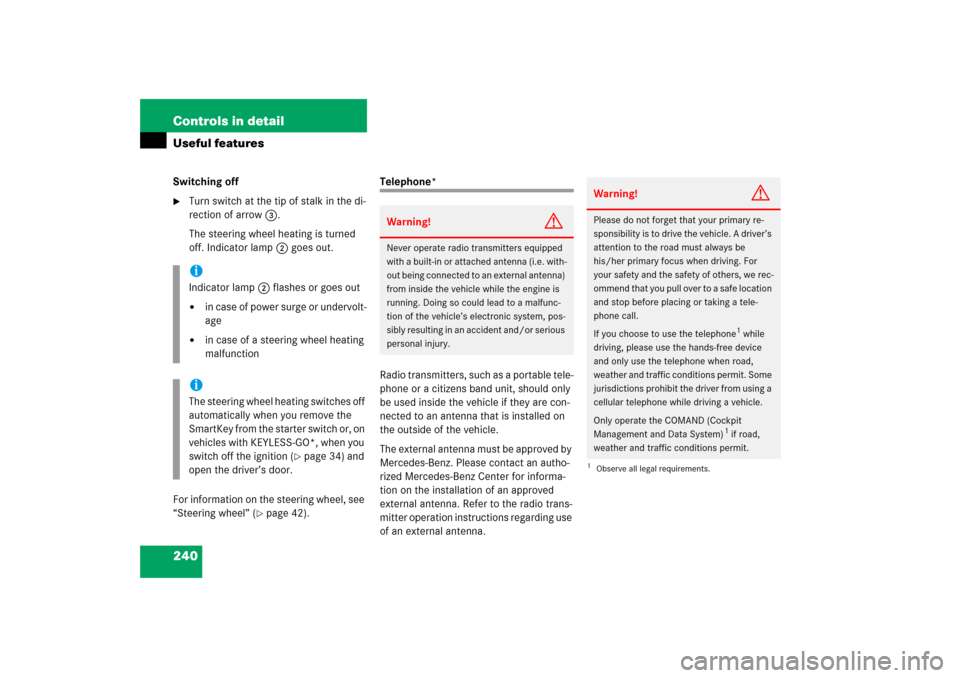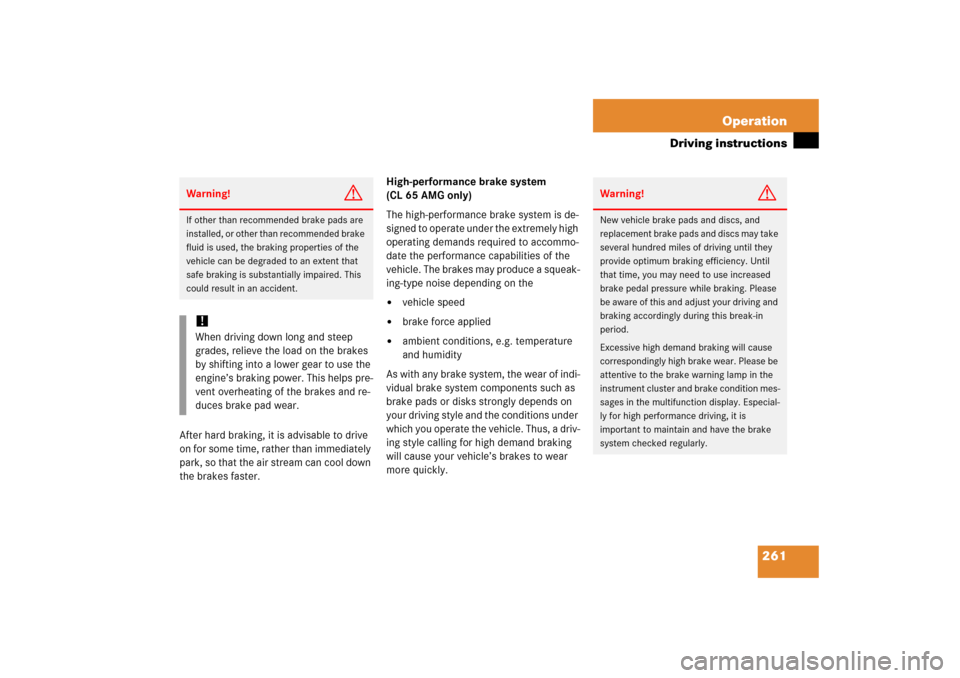Page 241 of 456

240 Controls in detailUseful featuresSwitching off�
Turn switch at the tip of stalk in the di-
rection of arrow3.
The steering wheel heating is turned
off. Indicator lamp2 goes out.
For information on the steering wheel, see
“Steering wheel” (
�page 42).
Telephone*
Radio transmitters, such as a portable tele-
phone or a citizens band unit, should only
be used inside the vehicle if they are con-
nected to an antenna that is installed on
the outside of the vehicle.
The external antenna must be approved by
Mercedes-Benz. Please contact an autho-
rized Mercedes-Benz Center for informa-
tion on the installation of an approved
external antenna. Refer to the radio trans-
mitter operation instructions regarding use
of an external antenna.
iIndicator lamp2 flashes or goes out �
in case of power surge or undervolt-
age
�
in case of a steering wheel heating
malfunction
iThe steering wheel heating switches off
automatically when you remove the
SmartKey from the starter switch or, on
vehicles with KEYLESS-GO*, when you
switch off the ignition (
�page 34) and
open the driver’s door.
Warning!
G
Never operate radio transmitters equipped
with a built-in or attached antenna (i.e. with-
out being connected to an external antenna)
from inside the vehicle while the engine is
running. Doing so could lead to a malfunc-
tion of the vehicle’s electronic system, pos-
sibly resulting in an accident and/or serious
personal injury.
Warning!
G
Please do not forget that your primary re-
sponsibility is to drive the vehicle. A driver’s
attention to the road must always be
his/her primary focus when driving. For
your safety and the safety of others, we rec-
ommend that you pull over to a safe location
and stop before placing or taking a tele-
phone call.
If you choose to use the telephone
1 while
driving, please use the hands-free device
and only use the telephone when road,
weather and traffic conditions permit. Some
jurisdictions prohibit the driver from using a
cellular telephone while driving a vehicle.
Only operate the COMAND (Cockpit
Management and Data System)
1 if road,
weather and traffic conditions permit.
1Observe all legal requirements.
Page 261 of 456

260 OperationDriving instructionsBrakesTo help prevent brake disk corrosion after
driving on wet road surfaces (particularly
salted roads), it is advisable to brake the
vehicle with considerable force prior to
parking. The heat generated serves to dry
the brakes.
If your brake system is normally only sub-
jected to moderate loads, you should occa-
sionally test the effectiveness of the
brakes by applying above-normal braking
pressure at higher speeds. This will also
enhance the grip of the brake pads.
Refer to the description of the Brake Assist
System (BAS) (
�page 81).If the parking brake is released and the
brake warning lamp in the instrument clus-
ter stays on, the brake fluid level in the res-
ervoir is too low.
Brake pad wear or a leak in the system may
be the reason for low brake fluid in the res-
ervoir.
Have the brake system inspected immedi-
ately. Contact an authorized
Mercedes-Benz Center.
All checks and service work on the brake
system should be carried out by qualified
technicians only. Contact an authorized
Mercedes-Benz Center.
Only install brake pads and brake fluid
recommended by Mercedes-Benz.
Warning!
G
After driving in heavy rain for some time
without applying the brakes or through wa-
ter deep enough to wet brake components,
the first braking action may be somewhat
reduced and increased pedal pressure may
be necessary to obtain expected braking ef-
fect. Maintain a safe distance from vehicles
in front.
Resting your foot on the brake pedal will
cause excessive and premature wear of the
brake pads.
It can also result in the brakes overheating,
thereby significantly reducing their effec-
tiveness. It may not be possible to stop the
vehicle in sufficient time to avoid an acci-
dent.
Warning!
G
Make sure not to endanger any other road
users when carrying out these braking ma-
neuvers.
Page 262 of 456

261 Operation
Driving instructions
After hard braking, it is advisable to drive
on for some time, rather than immediately
park, so that the air stream can cool down
the brakes faster.High-performance brake system
(CL 65 AMG only)
The high-performance brake system is de-
signed to operate under the extremely high
operating demands required to accommo-
date the performance capabilities of the
vehicle. The brakes may produce a squeak-
ing-type noise depending on the
�
vehicle speed
�
brake force applied
�
ambient conditions, e.g. temperature
and humidity
As with any brake system, the wear of indi-
vidual brake system components such as
brake pads or disks strongly depends on
your driving style and the conditions under
which you operate the vehicle. Thus, a driv-
ing style calling for high demand braking
will cause your vehicle’s brakes to wear
more quickly.
Warning!
G
If other than recommended brake pads are
installed, or other than recommended brake
fluid is used, the braking properties of the
vehicle can be degraded to an extent that
safe braking is substantially impaired. This
could result in an accident.!When driving down long and steep
grades, relieve the load on the brakes
by shifting into a lower gear to use the
engine’s braking power. This helps pre-
vent overheating of the brakes and re-
duces brake pad wear.
Warning!
G
New vehicle brake pads and discs, and
replacement brake pads and discs may take
several hundred miles of driving until they
provide optimum braking efficiency. Until
that time, you may need to use increased
brake pedal pressure while braking. Please
be aware of this and adjust your driving and
braking accordingly during this break-in
period.
Excessive high demand braking will cause
correspondingly high brake wear. Please be
attentive to the brake warning lamp in the
instrument cluster and brake condition mes-
sages in the multifunction display. Especial-
ly for high performance driving, it is
important to maintain and have the brake
system checked regularly.
Page 446 of 456

445 Index
P
Paintwork, Cleaning 319
Panic alarm 79
Parcel net
Front passenger footwell 234
Trunk 234
Parking 57, 262
Parking assist see Parktronic*
Parking brake 50, 58
Message in display 345
Warning sounds 51, 329
Parking lamps 125
Messages in display 357
Replacing bulbs 379, 382, 383
Parking position
Exterior rear view mirrors 124, 164,
180
Gear position, Automatic
transmission 48, 165, 167
Parktronic* 223, 430
Activating/deactivating 226
Cleaning system sensors 322
Malfunctioning 227
Minimum distance 225
Range of the sensors 224System sensors 322
Warning indicators 225
Warning sounds 225
Parts service 404
PASS AIR BAG OFF indicator lamp see
Front passenger front air bag off indica-
tor lamp 74
Passenger compartment 267
Fuse boxes 400
Interior lighting 131
Interior rear view mirror 43
Parcel net in front passenger
footwell 234
Passenger safety see Occupant safety
Pedals 259
Phone see Telephone*
Plastic parts, cleaning 324
Poly-V-belt drive 408, 430
Layout 407
Positions (Memory function) see Power
seats
Power assistance 259
Power closing assist for doors and trunk
lid 110Power seats 37, 112
Easy entry/exit feature 112
Folding back front seat backrests 40
Folding forward front seat
backrests 40
Heating 119
Lumbar support 117
Memory function 122
Multicontour* 117
Multicontour*, Lumbar support 118
Multicontour*, Massage function
(PULSE) 118
Multicontour*, Shoulder support 117
Multicontour*, Side bolsters 118
Ventilation* 121
Power tilt/sliding sunroof 202
Messages in display 359
Opening/closing in an
emergency 375
Operating 202
Operating, SmartKey 200
Operating, SmartKey with
KEYLESS-GO* 200
Stopping 204
Synchronizing 204
Power train 431